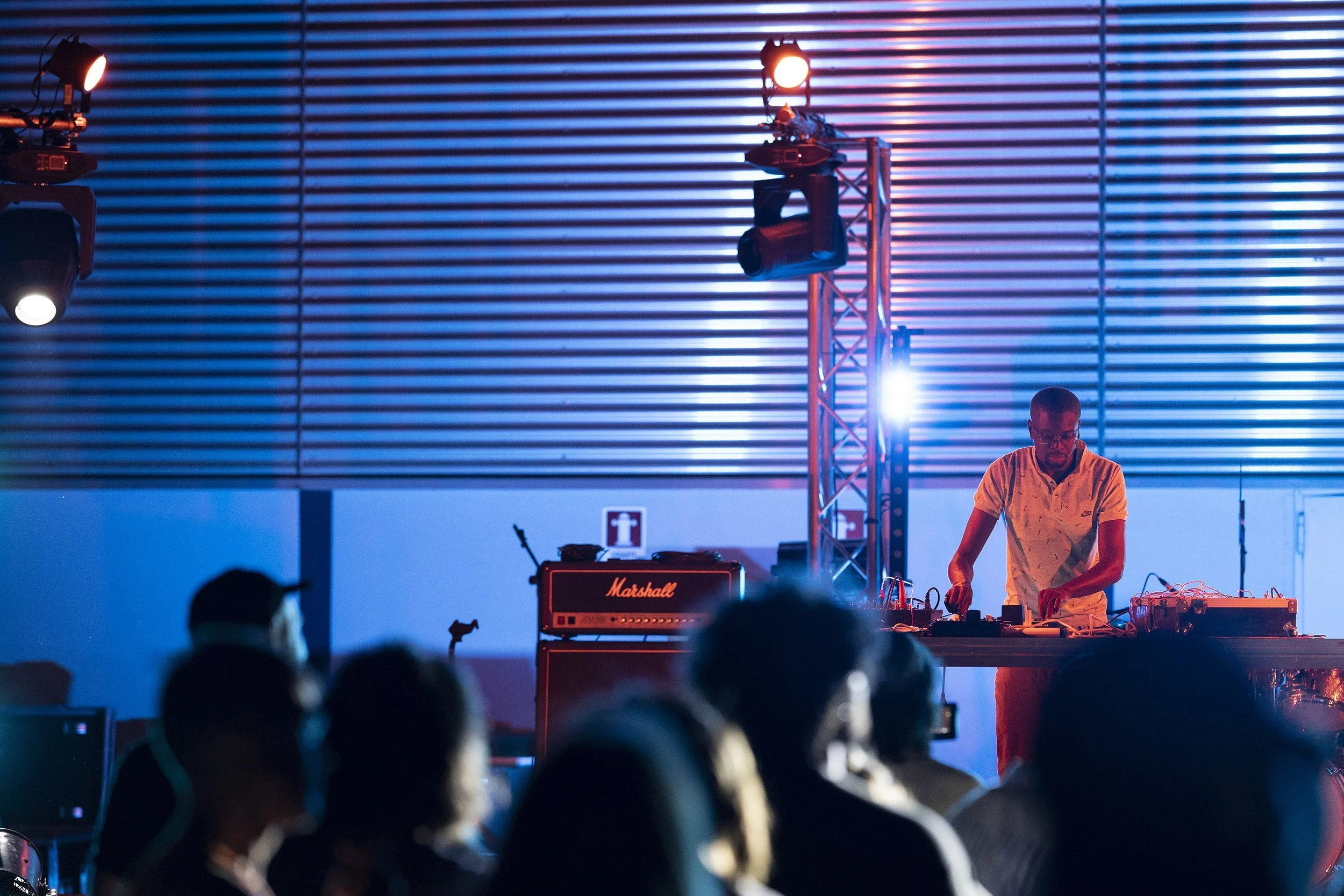Brian Bamanya offers a uniquely Ugandan take on electronic music as Afrorack
Performing on instruments he built himself using salvaged chips and capacitors, the experimental Kampala-based artist debuts in North America
Brian Bamanya, aka Afrorack.
Vancouver New Music presents Afrorack at Red Gate on September 27 at 8 pm; tickets sold out
STYMIED BY THE limited volume of the Italian bowl-back mandolin, Orville Gibson took matters into his own hands and applied violin technology to his chosen instrument, arriving at a sound that has been the standard for well over a century. Fifty years later, Leo Fender was a small-time radio repairman in small-town California, with no dreams of a career in music. But when his hillbilly clients started bringing him broken guitar amplifiers to fix, he realized that he could build better units, and soon did.
It’s too early to say whether Brian Bamanya will ever build a musical empire to rival Fender or Gibson, but from similarly humble beginnings the Kampala, Uganda–based performer and inventor has already a developed a signature sound—and one that’s attracting listeners on a global scale.
Working under the moniker Afrorack—which we’ll explain in a minute—Bamanya has devised a uniquely Ugandan take on electronic music, using instruments that he has built himself, often from salvaged chips and capacitors that otherwise might have become landfill. And, as with the original Gibson and the pioneering Fender, it all came about out of necessity.
After graduating from university, as Bamanya explains in a Zoom interview from his home, he’d started a rental business, supplying public address systems to bands, clubs, and DJs. On occasion, perhaps unsurprisingly, his gear would be returned in less-than-perfect condition.
“I needed someone to service my equipment,” he explains. “Things would go out and come back with issues, like the speakers would blow out sometimes, or the amplifiers weren’t working… I mean, just maintenance. So this particular guy was my number-one tech, but he was not reliable. Every time I’d take him my equipment I’d say ‘Oh, I need this repaired by Saturday. Someone’s waiting to use this PA system.’ And then I’d give him the money to motivate him to work, but when Saturday comes I can’t trust the guy. I’d go to his home, and I’m calling everyone, and they’d be like ‘No, we don’t know where the guy is.’
“I’d really get so frustrated by this, although he was quite good,” Bamanya adds. “When he’d work on this stuff he’d really work on it.”
Afrorack. Photo by Lorenzo Palmieri
Bamanya soon moved on from hovering over his friend’s workbench to watching YouTube repair videos and perusing circuit diagrams online. Fixing his rental gear led to building himself a guitar amplifier and some simple effects pedals.
“There’s a website that had an article on this famous wah-wah pedal, the classic sound and how it’s achieved,” he notes. “I looked at it and it was a pretty simple circuit: two transistors and an inductor and a few resistors and a battery. It’s not that I understood everything, but I knew how transistors worked, and I’d read about resistors and they seemed simple to understand, so I was trying out stuff. I’d make something that worked—or if it didn’t work I would trouble-shoot it and find out why it was not working.”
At the same time that he was expanding the sound of his electric guitar, Bamanya was also getting interested in electronic music. Techno had established a presence in Kampala’s club scene, and the Internet also led him to the pioneers of the field, people like Bob Moog and Don Buchla, whose early experiments gave us the future that we have today.
“I saw what they did in the ’60s and the ’70s,” he says, “and I thought ‘Well, what inspired them? They did so much with so little.’ In the ’60s it was pretty much new technology, and when you look at how they built their circuits, like the Moog filters and all this stuff, it’s quite amazing what they did for the time. It really inspired and encouraged me, and I thought ‘Since I have access to the Internet, right now I should be better positioned to understand what they did in the ’60s.’’
Economics were also a factor. Bamanya was drawn to the developing field of modular synthesis, in which aspiring musicians could assemble their own complex systems on a piece-by-piece basis, but as he notes, even the most basis modular elements could cost $200 or more. “If I wanted to buy a system of, like, 10 things I’d have to work for five years!”
So he built his own from scratch, calling it the Afrorack in playful homage to the expensive Eurorack modules that are the industry standard. And once he had the basics up and running, Bamanya went on to tweak his sound to more fully reflect his African heritage—as we’ll hear at Red Gate on September 27, when Afrorack makes its North American debut.
“When I got into this, part of the inspiration was American music: techno and all this stuff that I’d heard when I was 20,” he says. “That’s what I was at first trying to produce on my synthesizer. But I realized quickly that all of this had been experimented with. Techno was well-known music, so perhaps I should try to play my local, traditional African music on the synthesizer—like, African rhythms and melodies and stuff like that. And then quickly I realized that the way the instruments are created and built is with a Western understanding of what music can be. You know, 4/4. But our music here in Africa, a lot of our music has different time signatures. When I got my first controller I couldn’t play the rhythms I wanted. So I started building sequencers which can play the rhythms the way I want them, and I learned a lot about how to translate the rhythms which I’m more familiar with using what’s available.”
Bamanya considers his music an ongoing experiment, but it’s clearly a successful one. Judging by his 2022 debut, The Afrorack, he’s retained the sense of playful investigation that made early German and American electronic music so compelling, while adding layers of electro-percussion that happily avoid the rhythmic banality of much electronic pop. And there’s going to be more from where this first step came from.
“All that I’m doing now—all my knowledge, all my experience—is going towards making something local, something that has roots from where I come from,” Bamanya says, adding that he’s now helping other Ugandans to find their own way through the maze of electronic possibilities, both musical and technological.
“I was initially motivated by personal curiosity,” he adds. “But I’m beginning to think, like, ‘Why don’t we make this stuff in Africa? Why do we have to spend so much money paying for something made in a foreign country?’ So along the way this has become one of my driving factors.” ![]()

























